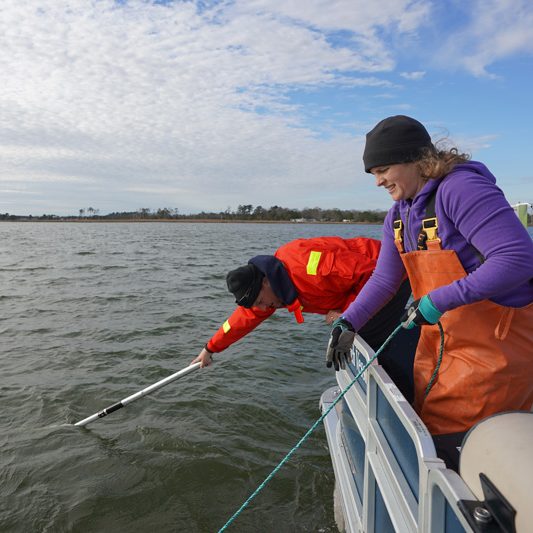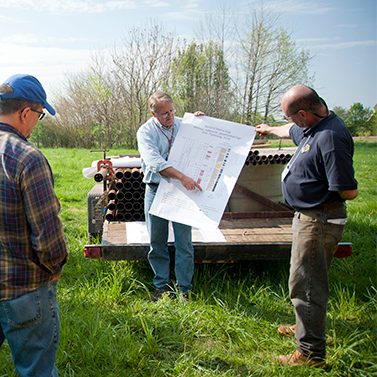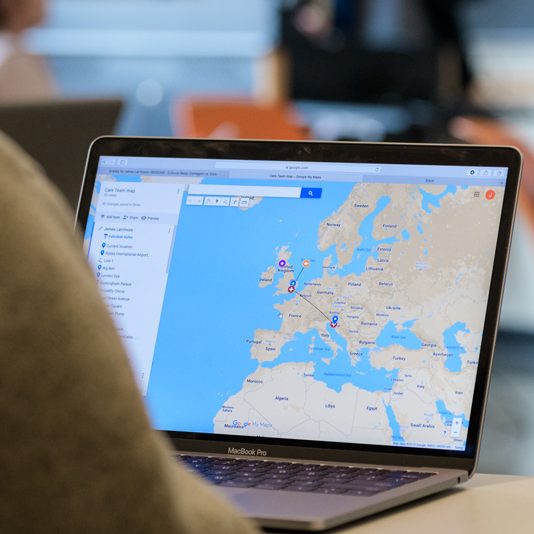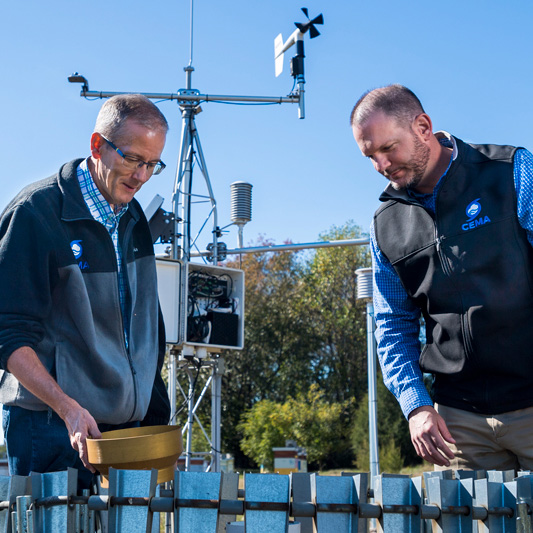
Facilities & Resources
The College of Earth, Ocean and Environment has several facilities and resources on the main campus in Newark, Del. and at the Hugh R. Sharp Campus in Lewes, Del. offering students, faculty and staff access to high-tech instruments for supporting studies and research.
Air-Sea-Current Flume
The tank overall length is 42 m with a working section 37 m long. It is 1m wide and 1.2 m high. Water depth is generally kept at 0.75 m to allow sufficient air space above the surface. The tank is equipped with a programmable wave maker, and a wind tunnel capable of up to 17m/s wind speed.. Air temperature and water temperature are also independently controllable and can be set from 5 to 40 degrees Celsius. Currents in the tank can be generated using a recirculating pump or by tilting the tank (up to 1.1 degrees). An artificial beach is placed at the end of the tank to dissipate wave energy and eliminate wave reflection. Read more >
Air-Sea Interaction Laboratory
Cape Henlopen State Park
15099 Cape Henlopen Drive
Lewes, DE 19958
302-831-6658
airsealab@udel.edu
www1.udel.edu/ASI-Lab/facilities/index.html
Lab manager: Fabrice Veron
Delaware Environmental Observing System
DEOS provides real-time environmental conditions for Delaware and the surrounding region. DEOS operates and maintains over 80 environmental monitoring platforms and brings in data from over 200 additional environmental monitoring platforms throughout our region. Read more >
Delaware Environmental Observing System
102 Pearson Hall
Newark, DE 19716-2541
Phone: (302) 831-6906
Fax: (302) 831-6654
Email: cema-info@udel.edu
www.deos.udel.edu
Director: Kevin Brinson
Real- Time Environmental Monitoring Locations:
- Throughout the State of Delaware
- Chester County, PA
- Fair Hill and North East, MD (Cecil County)
Environmental Isotope Science Lab
The Environmental Isotope Science Laboratory (EISL) is a facility for stable isotope-ratio measurements and environmental radioactivity that is housed in the Department of Earth Sciences at the University of Delaware (UD). It is directed by Prof. Neil Sturchio and staffed by a full-time Laboratory Manager. Read more >
Stable Isotope-Ratio Mass Spectrometry Laboratory
251 Patrick Harker Interdisciplinary Science and Engineering Laboratory (Harker ISE Lab)
221 Academy Street
Newark, DE 19716
Environmental Radioactivity Laboratory
007 Penny Hall
255 Academy Street
Newark, DE 19716
Geographic Information Systems (GIS) Labs
New upgrades to computer rooms in both Pearson Hall in Newark and Cannon Lab in Lewes allow for GIS teaching and research with the most up-to-date machines and software. The two rooms are connected by the college’s ITV system, allowing classes to reach students on both campuses simultaneously.
Newark Location:
Geographic Information Systems (GIS) Lab
Pearson Hall
125 Academy Street
Newark, DE 19716
Lewes Location:
Geographic Information Systems (GIS) Lab
Harry L. Cannon Laboratory
1044 College Drive
Lewes, DE 19958
Global Visualization Lab
Researchers use the video wall in the Global Visualization Lab to display and interpret data gathered from satellites, surface monitors and underwater robots to study ocean phenomena. The lab allows the various data collection technologies to not just work in parallel but integrate findings for a more complete picture across larger scales.
Global Visualization Lab
105 Otis H. Smith Laboratory
College Drive
Lewes, DE 19958
Lab manager: Matt Oliver
ITV Classrooms
CEOE's Interactive Television (ITV) system enables participants at both ends to see and hear each other in real time. By bridging the distance between our campuses in Newark and Lewes, ITV allows students to maximize their educational experience by being able to attend class and participate in symposiums on both campuses without commuting. Classrooms are equipped with Smartboards and computer screen share features to make the virtual classroom experience even more dynamic.
ITV classroom reservation form
MakerSpaces
Both CEOE and UD offer multiple MakerSpaces to encourage innovation and hands-on invention. The Robotic Discovery Laboratories (see entry below) include a workshop with tools for fabricating and modifying autonomous systems and other cutting-edge technology. Together with other spaces in the UD MakerNetwork, the Visualization and Advanced Simulation Training (VAST) Lab, the Geotechnology Education Lab (GEL), and the university’s newly opened MakerGym provide maker resources to students on main campus. Read more >
Newark locations:
UD MakerGym
Pearson Hall
125 Academy Street
Newark, DE 19716
Faculty lead: Art Trembanis
VAST Lab
Penny Hall (basement)
255 Academy Street
Newark, DE 19716
Lab director: Art Trembanis
Geotechnology Education Lab
203A Penny Hall
255 Academy Street
Newark, DE 19716
Lab director: Michael O'Neal
Lewes Location:
Robotic Discovery Laboratories
161 Otis H. Smith Laboratory
College Drive
Lewes, DE 19958
Marine Operations
One of the things that sets CEOE apart is that it owns and operates a regional class research vessel in the University-National Oceanographic Laboratory System (UNOLS) fleet, used by universities, government and private industry. The R/V Hugh R. Sharp is based in Lewes but conducts research cruises all along the East Coast and can spend weeks at a time at sea. The college has several smaller vessels as well, ideal for local research and educational use. Read more >
Adrian S. Hooper Marine Operations Building
700 Pilottown Road
Lewes, DE 19958
More information on Marine Operations >
Director of Marine Operations: Jon Swallow
Marine Studies Library
The Marine Studies Library is a branch library serving the Hugh R. Sharp
Campus in Lewes, Delaware. Access to the library is restricted
exclusively to the faculty, staff, and students of the College of Earth,
Ocean, and Environment. Group study areas are also provided. Read more >
Marine Studies Library
234 Harry L. Cannon Laboratory
1044 College Drive
Lewes, DE 19958
Email: lib-mars@udel.edu
Meteorology Visualization Lab
With half a dozen monitors displaying feeds from satellites, radar, real-time monitoring stations on the ground, and other sources, the Meteorology Visualization Lab provides a convenient and impactful space for teaching, forecasting and conducting research. The lab is adjacent to the Office of the Delaware State Climatologist, a faculty member in the Department of Geography and Spatial Sciences.
Meteorology Visualization Lab
Pearson Hall
125 Academy Street
Newark, DE 19716
Lab director: Dan Leathers
Robotic Discovery Laboratories
The Robotic Discovery Laboratories (RDL) combine the expertise of faculty members and research scientists who work in the area of underwater robotics, allowing them to discuss addressing problems with a variety of technologies and look for ways to integrate data across platforms. The laboratories house seven robots: six torpedoes and a block. The labs are outfitted with research space, work benches and storage areas
Robotic Discovery Laboratories
161 Otis H. Smith Laboratory
College Drive
Lewes, DE 19958
Satellite Receiving Station
The equipment benefits faculty and others who study changes in the mid-Atlantic environment. The station consists of an X-Band receiver for reception of the MODIS family of satellites which allows for the study of sea-surface temperature, chlorophyll concentrations, land surface temperatures, and vegetation patterns. An L-band receiver allows for the reception of NOAA, MetOP, and Fung-yen satellites to study atmospheric conditions, land surface temperatures, and sea surface temperatures. Read more >
Office Location:
Center for Environmental Monitoring & Analysis (CEMA)
216 Pearson Hall
Newark, DE 19716-2541
Phone: (302) 831-2294
Fax: (302) 831-6654
Email: udsrs-info@udel.edu
Please feel free to contact us regarding the UD SRS or any of our output products.
SRS Equipment Location:
Willard Hall Education Building (equipment on the roof)
16 West Main Street
Newark, DE 19716
Wind Turbine
UD and the former Gamesa Technology Corporation (now Siemens Gamesa) joined forces to install a 2-megawatt wind turbine. The turbine is used for research and education, as well as generating enough renewable energy to power the campus and about 100 homes in town for much of the year. Read more >
Wind Turbine
UD College of Earth, Ocean & Environment
Hugh R. Sharp Campus
Lewes, DE 19958




